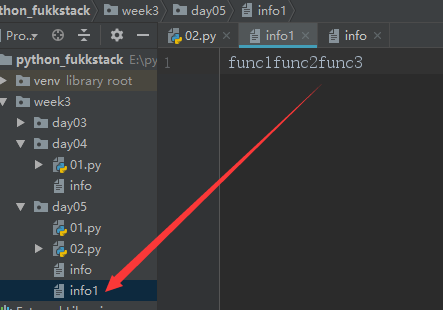1.编写装饰器,为多个函数加上认证的功能(用户的账号密码来源于文件)
要求成功登陆一次,后续的函数都无需输入用户名和密码
flag=1 def wrapper(f): def inner(*args): global flag while flag: username=input("username>>>") password=input("password>>>") with open('info',mode='r',encoding='utf-8') as file: line=file.readline().split(' ') if username==line[0] and password==line[1]: print("登录成功!") flag=0 #登陆成功之后后面的函数都无需再输入用户名密码 ret=f(*args) return ret return inner @wrapper def func1(a,b): return a+b @wrapper def func2(a,b,c): return a*b*c print('func1函数执行结果:',func1(1,2)) print('func2函数执行结果:',func2(1,2,3))
运行结果:

版本二(EVa-J):
flag=0 def wrapper(f): def inner(*args): global flag if flag: ret = f(*args) return ret else: username=input(">>>") password=input(">>>") with open('info',encoding='utf-8') as file: line=file.readline().split(' ') if username==line[0] and password==line[1]: print("登录成功") flag=1 ret=f(*args) return ret else: print("登录失败") return inner @wrapper def func1(a,b): return a+b @wrapper def func2(a,b,c): return a*b*c print(func1(1,2)) print(func2(1,2,3))
版本三(在上面基础上完善了一下,登陆失败后可以重新输入用户名密码,进行尝试)
flag=0 def login(f): def inner(*args): global flag logging=1 while logging: if flag: #登录成功,下次就不用在输入用户名密码了 ret = f(*args) return ret else: username=input("username>>>") password=input("password>>>") with open("info",mode='r',encoding='utf-8') as file: line=file.readline().split(' ') if username==line[0] and password==line[1]: print("登录成功!") flag=1 ret = f(*args) return ret else: print("登陆失败") if input("continue?(Y or N)>>>").upper()=='N': logging=0 return inner @login def add_shopping(a,b): print(a,b) return "增加商品" @login def del_shopping(a,b): print(a,b) return "删除商品" print(add_shopping(1,2)) print(del_shopping(1,2))
2.编写装饰器,为多个函数加上记录调用功能,要求每次调用函数都将被调用的函数名称写入文件:
def wrapper(f): def inner(*args): ret=f(*args) with open('info1',mode='a+',encoding='utf-8') as file: name=f.__name__ file.write(name) return ret return inner @wrapper def func1(a,b): return a+b @wrapper def func2(c,d,e): return c*d*e @wrapper def func3(a,b,c,d,e): return a,b,c,d,e print(func1(1,2)) print(func2(1,2,3)) print(func3(1,2,3,4,5))
运行结果:

这需要用到一个函数func.__name__ 可以得到func函数的函数名;
3.编写下载网页内容的函数,要求功能是:用户传入一个url,函数返回下载页面的结果:
def download(url): code=urlopen(url).read() return code
4.为3编写装饰器,实现缓存网页内容的功能:
from urllib.request import urlopen def cache(f): def inner(*args,**kwargs): with open('info2',mode='r+',encoding='utf-8') as file: line=file.readlines() if line: print("这是原来下载好的内容",line) else: ret=f(*args,**kwargs) file.write(str(ret)+' ') return ret return inner @cache def download(url): code=urlopen(url).read() return code print('这是新的要下载的内容:',download('https://zhidao.baidu.com/question/520009128815601365.html'))
版本二(Eva-J):
from urllib.request import urlopen import os def cache(f): def inner(*args,**kwargs): if os.path.getsize('infp3'): with open('infp3',mode='rb') as file: return file.read() else: ret=f(*args,**kwargs) with open("infp3",mode='wb') as file: file.write(b'****'+ret) return ret return inner @cache def func(url): ret=urlopen(url).read() return ret print(func('http://www.baidu.com')) print(func('http://www.baidu.com')) print(func('http://www.baidu.com'))

只有第一个是从网页中下载的内容读的(因为读的是ret的内容),后面两个因为第一个下载的内容已经写入文件了(前面加了***)所以独到的是***后面一堆~
上面写的有一个问题就是,如果来一个新的网址,因为文件里面已经有内容了,它读的还是原来网址下载的内容,这其实不合理 ,我们可以改成,来一个url 判断这个url有没有被下载过(可以建一个字典来存,url作为键)如果之前下载过,就从文件里面读取(带有***号的是之前已经下载到文件中了,从文件读取的,不是从网页上下载读到的),如果这个url之前 没有出现过就直接打印下载的网页内容:
from urllib.request import urlopen import os dict={} count=0 def cache(f): def inner(url): global dict global count if url in dict: with open("infp3",mode='rb') as file: return file.readlines() else: ret=f(url) with open('infp3',mode='ab') as file: file.write(b'***'+ret) dict[url]=count count += 1 return ret return inner @cache def func(url): ret=urlopen(url).read() return ret print(func("https://www.cnblogs.com/xuanxuanlove/p/9568322.html")) print(func("https://www.baidu.com")) print(func("https://www.baidu.com")) print(func("https://www.bilibili.com/")) print(func("https://www.bilibili.com/"))
运行结果:

第三个和第五个应该是从文件里面读的~
相比之前 第一个url 是从网页下载的,其他的url 不管是不是新的网址,都从文件读第一个url的内容,现在新的网址就从网页下载到文件,从网页读,旧的url 就从文件读(带有***)